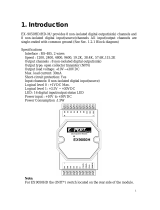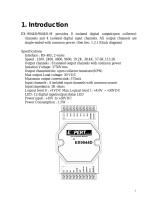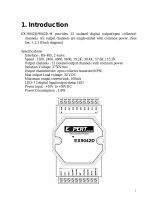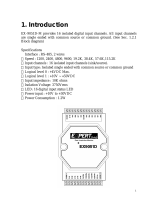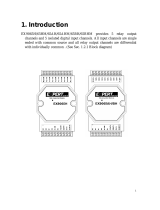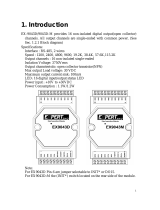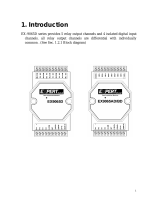Page is loading ...

GPS-721 User Manual
1/98 GPS-721 User Manual V2.0, Oct. 2010
GPS-721
User Manual v2.0
High-quality Industrial Data Acquisition and Control Products

GPS-721 User Manual
2/98 GPS-721 User Manual V2.0, Oct. 2010
Warranty
All products manufactured by ICP DAS are warranted against
defective materials for a period of one year from the date of delivery
to the original purchaser.
Warning
ICP DAS assumes no liability for damages consequent to the
use of this product. ICP DAS reserves the right to change this
manual at any time without notice. The information furnished by
ICP DAS is believed to be accurate and reliable. However, no
responsibility is assumed by ICP DAS for its use, or for any
infringements of patents or other rights of third parties resulting
from its use.
Copyright
Copyright 2010 by ICP DAS CO., LTD. All rights reserved
worldwide.
Trademark
The names used for identification only may be registered
trademarks of their respective companies.
Version Date Author Description
1.0 2010/2/1 Anold Release version

GPS-721 User Manual
3/98 GPS-721 User Manual V2.0, Oct. 2010
Table of Contents
1 Introduction............................................................................................................5
1.1 Features......................................................................................................6
1.2 Applications...............................................................................................6
1.3 Package List...............................................................................................7
1.4 Hardware....................................................................................................8
1.4.1 Specifications.................................................................................9
1.4.2 Block Diagram of GPS-721.........................................................11
1.4.3 Pin assignments and LED directors.............................................12
1.4.4 Operation modes..........................................................................13
1.4.5 Wiring Recommendations ...........................................................14
1.5 Wiring......................................................................................................15
1.6 Dimensions ..............................................................................................17
1.7 Mounting..................................................................................................18
1.8 Frame Ground..........................................................................................20
1.9 Configuration Table.................................................................................22
1.10 Quick start................................................................................................23
1.11 Technical Support....................................................................................25
2 DCON Protocol....................................................................................................26
2.1 %aannttccff..............................................................................................30
2.2 #**............................................................................................................33
2.3 #AA..........................................................................................................35
2.4 #AAN.......................................................................................................37
2.5 #AA00(Data)............................................................................................40
2.6 #AA0A(Data)...........................................................................................42
2.7 #AA1cDD................................................................................................44
2.8 #AAAcDD ...............................................................................................46
2.9 $AA2........................................................................................................48
2.10 $AA4........................................................................................................50
2.11 $AA5........................................................................................................52
2.12 $AA6........................................................................................................54
2.13 $AAC.......................................................................................................56
2.14 $AAD.......................................................................................................58
2.15 $AAF........................................................................................................60
2.16 $AAM......................................................................................................61
2.17 $AALS.....................................................................................................62
2.18 @AA........................................................................................................64
2.19 @AA(Data)..............................................................................................66

GPS-721 User Manual
4/98 GPS-721 User Manual V2.0, Oct. 2010
2.20 ~AAO(Name)...........................................................................................68
2.21 ~AAD.......................................................................................................70
2.22 ~AADVV.................................................................................................72
2.23 ~AAI ........................................................................................................74
2.24 ~AAM......................................................................................................76
2.25 ~AAMN...................................................................................................78
2.26 ~AATnn...................................................................................................81
2.27 ~** ...........................................................................................................84
2.28 ~AA0........................................................................................................85
2.29 ~AA1........................................................................................................87
2.30 ~AA2.......................................................................................................89
2.31 ~AA3EVV ..............................................................................................91
2.32 ~AA4V....................................................................................................93
2.33 ~AA5V....................................................................................................95
A.1 Dual Watchdog Operation ....................................................................................97
A.2 Node Information Area.........................................................................................98

GPS-721 User Manual
5/98 GPS-721 User Manual V2.0, Oct. 2010
1 Introduction
The I-7000 series is a family of network data acquisition and control
modules, providing analog-to-digital, digital-to-analog, digital
input/output, timer/counter and other functions. The modules can
be remotely controlled by using a set of commands, which we call
the DCON protocol. Communication between the module and the
host is in ASCII format via an RS-485 bidirectional serial bus
standard. Baud Rates are software programmable and
transmission speeds of up to 115.2 Kbps can be selected.
GPS-721 module features high sensitivity, low power and ultra
small form factor with DCON and GPS protocols. The inside GPS
module is powered by MediaTek solution and it can provide you
with superior sensitivity and performance even in urban canyon and
dense foliage environment. Except for the GPS data, GPS-721
includes 1 channel DO and 1 channel PPS for users to apply. A
Pulse per second (PPS) is an electrical signal that very precisely
indicates the start of a second. PPS signals can be used for precise
timekeeping and time measurement. One can combine the PPS
functionality with another time source that provides the full date and
time in order to ascertain the time both accurately and precisely.
Therefore, GPS-721 can be a powerful GPS remote module as well
as a general purpose GPS module with RS232 interface. It can also
be applied in Automotive navigation, Personal positioning and
navigation, Marine navigation, Satellite time correction and etc…

GPS-721 User Manual
6/98 GPS-721 User Manual V2.0, Oct. 2010
1.1
Features
MediaTek high-sensitivity GPS solution
Supports 66-channel GPS and NMEM v0183 v3.01
RS-485 supports the DCON protocol
RS-232 supports NEMA v0183 v3.01 format or the DCON
protocol
Built-in 1 channel DO, 1 channel PPS (1 pulse per second), 1
RS-485 port and 1 RS-232 port
PPS: 100 ms pulse output/sec for precise timekeeping and time
measurement
10 ~ 30V DC – (Power reverse polarity protection)
System LED indicators
DIN Rail design
1.2 Applications
Automotive navigation
Personal positioning and navigation
Marine navigation
Satellite time correction
Precise timekeeping and time measurement

GPS-721 User Manual
7/98 GPS-721 User Manual V2.0, Oct. 2010
1.3 Package List
Item Quantity
GPS-721 1
External GPS antenna (ANT-115-03,
Length: 5m)
1
RS-232 Cable (CA-0910) 1
Product CD 1
Quick Start Guide 1
Please check that these items and contained in your GPS-721
package. If there are any problems, contact the supplier of the
module.

GPS-721 User Manual
8/98 GPS-721 User Manual V2.0, Oct. 2010
Number of satellites LED
INIT/Normal Switch
Hardware

GPS-721 User Manual
9/98 GPS-721 User Manual V2.0, Oct. 2010
1.3.1 Specifications
General specifications:
GPS Receiver
Chip MediaTek solution
Frequency L1 1575.42 MHz, C/A code
Support Channel 32
Position Accuracy Capable of SBAS (WAAS, EGNOS, MSAS)
Max. Altitude <18,000 m
Max. Velocity <515 m/s
Acquisition Time Cold Start (Open Sky) = 42 s (typical)
Sensitivity Tracking=Up to -158 dBm
Cold start=Up to -142 dBm
Protocol Support NMEA 0183 version 3.01
GPS Antenna (default)
Length 5 m
Frequency Range 1575.42 ± 1.023 MHz.
Gain At 90° 30 ± 4.5dBi – (cable loss)
Mounted on the 60mm*60mm ground plane.
Output Impedance 50Ω
VSWR 2.0 Max
GPS Output
1 PPS Pulse per Second Output (Default 100 ms
pulse/sec)
RS-232 Interface GPS Information Output
LED Indicators
Power/Communication 1 LED
GPS 3 LEDs
Power
Protection Power reverse polarity protection
Frame Ground for ESD Yes
Protection
Required Supply Voltage +10 V DC ~ +30 V DC (non-regulated)
Power Consumption 2.5 W
Mechanical
Dimensions (W x H x D) 72 mm x 117 mm x 35 mm
Weight 200 g
Housing Plastic

GPS-721 User Manual
10/98 GPS-721 User Manual V2.0, Oct. 2010
Environment
Operating Temperature -25°C ~ +75°C
Storage Temperature -40°C ~ +80°C
Humidity 5 ~ 95% RH, non-condensing
I/O specification
Digital Output
Output Channel 1 (Sink)
Output Type Non-isolated Open Collector
Output Current 100 mA
Load Voltage +5 V DC ~ +30 V DC

GPS-721 User Manual
11/98 GPS-721 User Manual V2.0, Oct. 2010
1.3.2 Block Diagram for the GPS-721

GPS-721 User Manual
12/98 GPS-721 User Manual V2.0, Oct. 2010
1.3.3 Pin assignments and LED indicators
Pin assignments
LED indicators
LED Status Description
ON The module is operating / functioning correctly.
Sys.
OFF
There is an error with the module.
The module has encountered an error.
ON Digital Output is active.
DO1
OFF Digital Output is off.
ON
The number of signals received from GPS
satellites is less than 5. S1
OFF Module can’t receive any GPS signals.
ON
The number of signals received from GPS
satellites is 5 ~ 8 or above.
S2
OFF
The number of signals received from GPS
satellites is less than 5.
ON
The number of signals received from GPS
satellites is more than 8.
S3
OFF
The number of signals received from GPS
satellites is less than 8.
ON The PPS is on.
1 PPS
OFF The PPS is off.

GPS-721 User Manual
13/98 GPS-721 User Manual V2.0, Oct. 2010
1.3.4 Operation modes
The GPS-721 back panel contains the frame ground and Init/Normal
Switch. The module has two operation modes (init and normal modes),
which can be determined by the switch mechanism on the chassis. The
description and figure are as follows.
Mode Description
Init
After setting the module to “INIT” mode and restart
the module, a connection can be established using
the default module address and communication
settings, allowing new parameters for the module to
be set.
Init mode:
Protocol: DCON
Module Address: 00
Communication Baud Rate: 9600bps
Checksum: Disabled
Note: The DCON command to set the address,
BaudRate and checksum is %AANNTTCCFF. Refer
to section 2.1 for details.
Normal
In Normal mode, the module will operate based on
the user’s settings.

GPS-721 User Manual
14/98 GPS-721 User Manual V2.0, Oct. 2010
1.3.5 Wiring Recommendations
Use 26-12 AWG wire for signal connections.
Strip the wire to a length of 7±0.5mm.
Use a crimp terminal for wiring.
Avoid high-voltage cables and power equipment as much
as possible.
For RS-485 communication, use insulated and twisted pair
24 AWG wire, e.g. Belden 9841.

GPS-721 User Manual
15/98 GPS-721 User Manual V2.0, Oct. 2010
1.4 Wiring
DO wiring
PPS wiring

GPS-721 User Manual
16/98 GPS-721 User Manual V2.0, Oct. 2010
The PPS would output the pulse when receiving effective GPS
signals. That would output 100 ms pulse per second. The figure is
as follows.
Note: A Pulse per second (PPS) is an electrical signal that very
precisely indicates the start of a second. PPS signals can be
used for precise timekeeping and time measurement. one
can combine the PPS functionality with another time source
that provides the full date and time in order to ascertain the
time both accurately and precisely.
1 second 100 ms

GPS-721 User Manual
17/98 GPS-721 User Manual V2.0, Oct. 2010
Rear View
1.5
Dimensions

GPS-721 User Manual
18/98 GPS-721 User Manual V2.0, Oct. 2010
1.6 Mounting
The GPS-721 can be mounted on a DIN rail, a wall or it can be
piggybacked to other modules using the bottom of the chassis.
DIN-Rail Mounting
The GPS-721 has simple rail clips for reliable mounting on a
standard 35 mm DIN rail.
There are three new DIN rail models available. Each is made of
stainless steel, which is stronger than those made of aluminum.
There is a screw at one end, and a ring terminal is included so
that it can be easily connected to the earth ground. The three
new DIN rail models are as follows:
Note: It is recommended that a 16 – 14 AWG wire is used to
connect the DIN rail to the earth ground.

GPS-721 User Manual
19/98 GPS-721 User Manual V2.0, Oct. 2010
Piggyback Mounting
The GPS-721 has two holes on both sides of the module to enable
piggyback mounting. Refer to the figure below for an illustration of
how to piggyback the modules.

GPS-721 User Manual
20/98 GPS-721 User Manual V2.0, Oct. 2010
1.7 Frame Ground
Electronic circuits are constantly vulnerable to Electro-Static
Discharge (ESD), which becomes worse in a continental climate
area. Some I-7K and M-7K series modules feature a new design for
the frame ground, which provides a path for bypassing ESD,
allowing enhanced static protection (ESD) capabilities and ensures
that the module is more reliable. Either of the following options will
provide a better protection for the module:
1. If the module is DIN-rail mounted, connect the DIN rail to the
earth ground because the DIN rail is in contact with the upper
frame ground, as shown in the figure below.
2. Alternatively, connect the lower frame ground terminal to a wire
and connect the wire to the earth ground, as shown in the figure
below.
/
